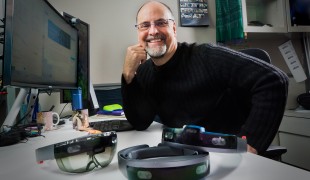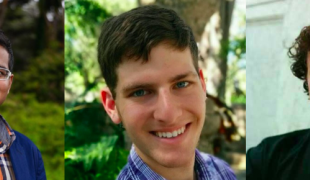- 8109
- 432
- 11
- 11
- 1
- Help Ukraine
About the solution
The HaptImage technology works thanks to an algorithm that changes digital images into physical sensations that impersonate the would-be exterior of a portrayed object. The users hold a joystick that resembles an ink pen that makes vibrations and resistance in correspondence with the digital object’s shape and feel while users move the joystick around.
This system can help blind students in classes. “The technology helps students interact in real-time while in a classroom and creates ‘touch-based learning.’ That is critical for all students, but especially for students who are blind or have limited vision. Real-time access to images is crucial to allow social integration and education for individuals who are blind or with limited vision. The technology not only helps with social integration for students, but it also will help individuals with visual impairments pursue image-dependent careers, such as architecture, and access social media platforms, such as Instagram,” Shruthi Suresh explained.
The team also works with Brad Duerstock, a professor with the School of Industrial Engineering and the Weldon School of Biomedical Engineering, where these women are PhD students. He is also the CEO of HaptImage.
“We were inspired to develop the technology by Greg Williams, who is a research assistant in Dr Duerstock’s lab and who is visually impaired. He was having difficulties viewing images related to his chemistry major and we wanted to do something to make it easier for him and others like him who face this extra challenge,” Ting Zhang described.
Adapted from: https://bit.ly/2O3asH8
More info: http://haptimage.com/
https://www.youtube.com/embed/teJXnc9lP1w
这些解决方案不应包括使用药物,化学品或生物制品(包括食品);创伤性设备;冒犯性的,商业或内在危险的内容。该解决方案未经医学验证。请谨慎进行!如果您有任何疑问,请咨询健康专家。
DISCLAIMER: This story was written by someone who is not the author of the solution, therefore please be advised that, although it was written with the utmost respect for the innovation and the innovator, there can be some incorrect statements. If you find any errors please contact the patient Innovation team via info@patient-innovation.com
-
-
363
-
0
-
4181

Using AI to allow blind people to find familiar faces
COMMUNICATION: Communicating, whether by speaking, listening, or other means
Social interaction
Blindness
5 Senses support devices: (glasses, hearing aids, headphones...)
Body-Worn solutions (Clothing, accessories, shoes, sensors...)
App (Including when connected with wearable)
AI algorithm
Assistive Daily Life Device (to help ADL)
Difficulty communicating with environment
Confusion
Regaining sensory function
Promoting self-management
Promoting inclusivity and social integration
Improving Speech and Communication
Raise awareness
Ophthalmology
Pediatrics
United States
-
-
-
545
-
0
-
8191

ThirdEye – App to help the blind
COMMUNICATION: Communicating, whether by speaking, listening, or other means
Reading
CAREGIVING
Blindness
App (Including when connected with wearable)
5 Senses support devices: (glasses, hearing aids, headphones...)
Vision problems
Regaining sensory function
Promoting self-management
Neurology
Ophthalmology
United States
-
-
-
404
-
0
-
6164

Parents bring together experts to create smart glasses for their son suffering from low vision
COMMUNICATION: Communicating, whether by speaking, listening, or other means
CAREGIVING
WALKING: Walking
Urban exploration
Tunnel Vision
5 Senses support devices: (glasses, hearing aids, headphones...)
Assistive Daily Life Device (to help ADL)
Vision problems
Regaining sensory function
Promoting self-management
Preventing (Vaccination, Protection, Falls, Research/Mapping)
Caregiving Support
Neurology
Ophthalmology
Pediatrics
Spain
-
 zh
zh
flintknowledge • Wed, 12/07/2022 - 03:52
你的文章非常有吸引力,有详细的说明。希望在您有下一篇文章时收到您的来信。